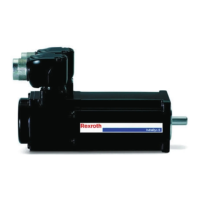4.3 Motor-internal holding brake
In normal operation, use the optional holding brake only when at a standstill
and when performing the drive-internal brake check. In this case, tempera‐
tures of T<100 °C occur. Sparks are not generated because there is no sur‐
facing of the brake pads.
Brake control
The switching voltage applied at the motor is influenced by the length of the
connection cable and its conductor resistance.
Therefore, the power supply of the holding brake has to be designed so as to
make a voltage of 24 volt +/- 10 % available at the motor for releasing/apply‐
ing the holding brake, even under the worst installation and operation condi‐
tions.
If a fault occurs during operation, causing a voltage deviation, this fault must
be detected and eliminated immediately. The fault can be identified, for ex‐
ample, using a monitoring device for undervoltage.
Malfunction
Only in the event of a malfunction, i.e. in the case of a fault in the system,
may the brake be activated when the motor is turning, in order to prevent a
dangerous lowering of vertical axes, for example, and to support other meas‐
ures. In this case, sparks may be generated in the brake and increased tem‐
peratures may occur within the motor. When a fault occurs, the operator must
eliminate it immediately.
Functional test
Before commissioning and, during operation, at periodic intervals (e.g. every
8 hours), the function of the brake is to be checked in the framework of an
appropriate brake test. A defined torque is applied to the motor to check
whether the brake has been completely released. In the case of certain drive
controller types, it is possible to carry out an integrated brake test using the
brake check command. Further information and data can be found in the re‐
spective functional descriptions of the drive controller firmware.
Bosch Rexroth AG DOK-MOTOR*-IDYN*A*EXPD-IB05-EN-P22/69
Rexroth MAD and MAF Motors in EX px d Design acc. to ATEX Directive 2014/34/EU
Application conditions

